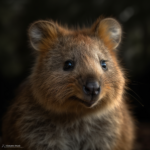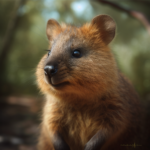The quokka, scientifically known as Setonix brachyurus, is a small marsupial native to Western Australia. Known for its adorable appearance and friendly demeanor, the quokka has gained popularity as one of the happiest animals on Earth. In this article, we will explore the weight and height of these fascinating creatures, shedding light on their physical characteristics and providing insights into their unique adaptations. So, let’s delve into the world of quokkas and discover more about their size and proportions.
Key Takeaways
- Quokkas are small marsupials found in Australia.
- Adult quokkas typically weigh between 2.5 to 5 kilograms.
- The height of a quokka is around 40 to 54 centimeters.
- Quokkas have a stocky build and short legs, which allows them to move quickly and efficiently in their habitat.
Understanding Quokkas: An Overview
A. What is a Quokka?
Quokkas are small marsupials that belong to the macropod family, which includes kangaroos and wallabies. These adorable creatures are native to the southwestern region of Australia, specifically found in the forests and scrublands of Rottnest Island, Bald Island, and some parts of the mainland. Quokkas have become famous for their friendly and approachable nature, earning them the title of “the world‘s happiest animal.”
Quokkas have a unique appearance, with a compact and stocky build. They have a round face, small ears, and a short, broad tail. Their fur is coarse and dense, ranging in color from sandy brown to gray. One of the most distinctive features of a quokka is their cheeky smile, which is formed by the shape of their mouth and the positioning of their teeth.
B. Where are Quokkas Found?
Quokkas are primarily found on Rottnest Island, located off the coast of Western Australia. This island is known as the main stronghold for the quokka population, with an estimated 10,000 individuals residing there. The absence of predators on the island has allowed the quokkas to thrive and maintain a stable population.
In addition to Rottnest Island, quokkas can also be found on Bald Island and in small pockets along the southwestern coast of Western Australia. However, their numbers are significantly lower in these areas compared to Rottnest Island.
The limited distribution of quokkas is due to their specific habitat requirements. They prefer dense vegetation, such as shrubs and grasses, which provide them with shelter and a source of food. Quokkas are also known to be excellent climbers, allowing them to navigate through the trees and bushes with ease.
Overall, the unique characteristics and limited distribution of quokkas make them a fascinating and sought-after species to observe in their natural habitat. Their presence on Rottnest Island has also contributed to the island‘s popularity as a tourist destination, attracting visitors from around the world who are eager to catch a glimpse of these delightful creatures.
Quokka Size: A Closer Look

A. How Big are Quokkas?
Quokkas, known for their adorable and friendly appearance, are small marsupials that belong to the macropod family. They are native to Western Australia, specifically found on Rottnest Island and a few other locations in the region. When it comes to their size, quokkas are relatively small compared to other macropods like kangaroos and wallabies.
On average, adult quokkas measure around 40 to 54 centimeters (15.7 to 21.3 inches) in length from head to tail. Their tails alone can reach a length of 25 to 30 centimeters (9.8 to 11.8 inches). Despite their small stature, quokkas have a robust build with a rounded body and short limbs. Their compact size allows them to navigate through dense vegetation and hop around with agility.
B. Quokka Weight: An In-depth Analysis
Quokkas, although small, have a surprising weight range. Adult quokkas typically weigh between 2.5 to 5 kilograms (5.5 to 11 pounds). However, there can be some variation in weight depending on factors such as age, sex, and overall health. Male quokkas tend to be slightly larger and heavier than females.
Quokkas have a stocky build, which contributes to their weight. They have a well-developed musculature, especially in their hind legs, enabling them to hop efficiently. Their bodies are covered in dense fur, which adds to their overall weight. This fur helps protect them from the elements, as they inhabit a variety of habitats ranging from forests to coastal areas.
C. Quokka Height: What to Expect
When it comes to the height of quokkas, they stand at an average of 40 to 54 centimeters (15.7 to 21.3 inches) at the shoulder. This measurement is taken from the ground to the highest point of their shoulders. Quokkas have a slightly hunched posture, which adds to their unique appearance.
Despite their small size, quokkas have a remarkable ability to jump. They can leap up to a meter (3.3 feet) in the air, allowing them to navigate their environment effectively. Their strong hind legs provide the power needed for these impressive jumps.
In comparison to other macropods, such as kangaroos and wallabies, quokkas are relatively shorter in height. However, their compact size and agility make them well-suited for their natural habitat.
To summarize, quokkas are small marsupials with a length ranging from 40 to 54 centimeters (15.7 to 21.3 inches) and a weight range of 2.5 to 5 kilograms (5.5 to 11 pounds). They stand at an average height of 40 to 54 centimeters (15.7 to 21.3 inches) at the shoulder. Despite their small stature, quokkas possess a robust build and are known for their ability to hop and jump with agility.
The Quokka Diet: Impact on Size and Weight
A. How Much Do Quokkas Eat a Day?
When it comes to the diet of quokkas, these small marsupials have specific eating habits that contribute to their size and weight. Quokkas are herbivores, which means they primarily feed on plants and vegetation. Their diet consists of a variety of leaves, grasses, stems, and bark. They also consume fruits and seeds when available.
Quokkas have a relatively low metabolic rate, which means they don’t require a large amount of food to sustain themselves. On average, a quokka consumes about 200 grams of food per day. However, their food intake can vary depending on factors such as the availability of food sources and the season.
B. The Role of Diet in Quokka’s Weight and Height
The diet of a quokka plays a crucial role in determining its weight and height. Since quokkas primarily feed on vegetation, their diet is relatively low in calories compared to carnivorous animals. This contributes to their small size and lightweight physique.
The limited availability of high-calorie food sources also affects the quokka’s weight and height. Quokkas have adapted to survive in their natural habitat, which consists of dense vegetation and limited resources. As a result, they have evolved to be smaller and more agile, allowing them to navigate through their environment more efficiently.
C. Understanding the Quokka’s Eating Habits
Quokkas are known for their grazing behavior, which involves feeding on small amounts of food throughout the day. They have a selective feeding pattern and prefer tender leaves and shoots. This behavior helps them maximize their nutrient intake from the available food sources.
Quokkas are also known to exhibit coprophagy, which is the consumption of their own feces. This behavior allows them to extract additional nutrients from their food by re-digesting it. While it may seem unusual, coprophagy is a common behavior among many herbivorous animals and serves as a way to optimize nutrient absorption.
In conclusion, the diet of a quokka directly impacts its size and weight. Their herbivorous diet, low metabolic rate, and selective feeding habits contribute to their small stature and lightweight physique. By understanding the quokka’s eating habits, we can gain insight into the factors that shape their physical characteristics.
Comparing Quokka Size: A Comparative Analysis

A. How Heavy is a Quokka Compared to Other Marsupials?
When it comes to the weight of a quokka, these adorable marsupials fall on the smaller end of the spectrum. Quokkas are generally lightweight compared to other marsupials, making them one of the smallest members of the macropod family.
To give you an idea of their weight range, adult quokkas typically weigh between 2.5 to 5 kilograms (5.5 to 11 pounds). However, it’s important to note that there can be slight variations in weight depending on factors such as age, sex, and overall health.
In comparison to their larger marsupial relatives like kangaroos and wallabies, quokkas are significantly lighter. For instance, a red kangaroo, the largest marsupial, can weigh up to 90 kilograms (200 pounds) or more. This stark contrast in weight highlights the petite nature of the quokka.
B. Size Differences: Male Quokkas Vs Female Quokkas
When it comes to size, there are some notable differences between male and female quokkas. Generally, male quokkas tend to be slightly larger than their female counterparts.
On average, male quokkas measure around 54 to 63 centimeters (21 to 25 inches) in length, from head to tail. In comparison, female quokkas are slightly smaller, measuring around 50 to 54 centimeters (20 to 21 inches) in length.
While the size difference between male and female quokkas is not significant, it is still noticeable. This variation in size is a common characteristic among many marsupial species, where males tend to be slightly larger to accommodate their role in reproduction and mating rituals.
It’s important to remember that these measurements are approximate averages and can vary from individual to individual. Additionally, quokkas have compact and stocky bodies, with short legs and a round face, giving them their distinctive appearance.
To summarize, quokkas are relatively small marsupials, weighing between 2.5 to 5 kilograms (5.5 to 11 pounds) on average. Male quokkas are slightly larger than females, with males measuring around 54 to 63 centimeters (21 to 25 inches) in length, while females measure around 50 to 54 centimeters (20 to 21 inches). These size differences contribute to the unique charm and appeal of these delightful creatures.
Factors Influencing Quokka Size
A. The Role of Genetics in Quokka Size
When it comes to the size of quokkas, genetics plays a significant role. Like any other living creature, quokkas inherit certain physical characteristics from their parents. These genetic factors determine the overall size and body proportions of these adorable marsupials.
Quokkas belong to the macropod family, which also includes kangaroos and wallabies. However, compared to their larger relatives, quokkas are relatively small in size. They have a stocky build with a round face and short limbs. The size of a quokka can vary slightly depending on its genetic makeup.
Within the quokka population, there may be variations in size due to genetic diversity. Some individuals may be slightly larger or smaller than others. However, these differences are generally minimal, and quokkas tend to have a consistent size range.
B. The Impact of Environment on Quokka Weight and Height
While genetics play a significant role in determining quokka size, the environment also has an impact on their weight and height. Quokkas inhabit the southwestern region of Western Australia, where they are exposed to a range of environmental conditions.
The availability of food resources and the quality of their habitat can influence the overall health and size of quokkas. A well-nourished quokka living in an environment with abundant food sources is more likely to reach its full growth potential.
Quokkas primarily feed on a variety of vegetation, including grasses, leaves, and bark. The nutritional value and availability of these food sources can affect their growth and development. In times of drought or scarcity, quokkas may experience stunted growth or reduced body weight.
Additionally, the overall health of the quokka population can be influenced by factors such as predation, competition for resources, and human activities. These factors can indirectly impact the size and weight of quokkas by affecting their overall well-being and reproductive success.
In conclusion, while genetics play a significant role in determining quokka size, the environment also has an impact on their weight and height. The interplay between genetics and the environment ultimately shapes the physical characteristics of these fascinating marsupials. By understanding these factors, we can gain a deeper appreciation for the unique traits and adaptations of the quokka.
The Significance of Quokka Size: An Ecological Perspective

A. How Quokka Size Affects Survival
The size of an animal plays a crucial role in its ability to survive and thrive in its environment. This holds true for the adorable and unique quokka, a small marsupial native to Western Australia. While quokkas may appear small and harmless, their size has a significant impact on their survival in the wild.
1. Adaptability to Limited Resources
Quokkas have evolved to be small in size, with an average weight ranging from 2.5 to 5 kilograms (5.5 to 11 pounds). This compact stature allows them to adapt to their natural habitat, which is characterized by limited resources such as food and water. By being smaller, quokkas require less sustenance to survive, making them more resilient in times of scarcity.
2. Mobility and Predation
Another advantage of the quokka’s size is its mobility. Being small and agile enables quokkas to navigate through dense vegetation and escape potential predators more easily. Their compact bodies allow them to maneuver swiftly, making it challenging for larger predators to catch them. This increased mobility enhances their chances of survival in the face of predation.
3. Reproduction and Population Dynamics
Quokka size also influences their reproductive capabilities and population dynamics. Female quokkas have a pouch where they carry and nurse their young, similar to other marsupials. The size of the pouch limits the number of offspring a female can carry at a time. The smaller size of quokkas means that they typically have smaller litters compared to larger marsupials. This reproductive strategy allows quokkas to invest more energy and resources into each individual offspring, increasing their chances of survival.
B. The Role of Quokka Size in Ecosystem Balance
Quokkas not only impact their own survival through their size, but they also play a vital role in maintaining the balance of their ecosystem. Their size influences various ecological aspects, contributing to the overall health and stability of their habitat.
1. Herbivory and Vegetation Control
Quokkas primarily feed on vegetation, including grasses, leaves, and stems. Their small size allows them to access a wide range of plant species and parts, contributing to the dispersal of seeds and the control of vegetation growth. By grazing on different plants, quokkas help maintain a diverse plant community and prevent the dominance of any particular species. This herbivory behavior is crucial for the overall balance and biodiversity of their ecosystem.
2. Nutrient Cycling
As quokkas consume plant material, they play a role in nutrient cycling within their ecosystem. Through digestion and excretion, they release nutrients back into the environment, enriching the soil and facilitating the growth of plants. This nutrient cycling is essential for the health and productivity of the ecosystem as a whole.
3. Interactions with Other Species
Quokkas also interact with other species within their habitat, both directly and indirectly. Their small size allows them to coexist with a variety of animals, such as birds, reptiles, and insects. These interactions contribute to the intricate web of relationships within the ecosystem, promoting biodiversity and ecological stability.
In conclusion, the size of quokkas is not merely a physical characteristic but holds significant ecological significance. Their small stature enables them to adapt to limited resources, enhances their mobility and survival against predators, influences their reproductive strategies, and contributes to the balance of their ecosystem through herbivory, nutrient cycling, and interactions with other species. Understanding the ecological perspective of quokka size provides valuable insights into the intricate dynamics of their natural habitat. Conclusion
In conclusion, the quokka is a fascinating and unique marsupial that is native to Western Australia. Despite its small size, the quokka has a relatively robust build, with an average weight of around 2.5 to 5 kilograms and a height of approximately 40 to 54 centimeters. These adorable creatures have adapted to their island habitat, developing strong hind legs for hopping and climbing, as well as a compact body shape that allows them to navigate through dense vegetation. The quokka‘s weight and height may vary slightly depending on factors such as age, sex, and overall health. However, these measurements give us a good understanding of the general size of these delightful animals. Whether you’re admiring them in photographs or lucky enough to encounter them in person, the quokka’s compact stature and charming appearance make them a true wonder of the animal kingdom.
Frequently Asked Questions
How big are quokkas?
Quokkas are small marsupials, about the size of a domestic cat. They typically measure 40 to 54 cm (16 to 21 in) in length, with an additional tail length of 25 to 30 cm (9.8 to 11.8 in).
What is the average weight and height of a quokka?
The average weight of a quokka is between 2.5 to 5 kg (5.5 to 11 lbs), and they stand at a height of about 30 to 40 cm (12 to 16 in).
How much do quokkas eat in a day?
Quokkas are herbivores and primarily eat a variety of plants, including grasses and leaves. They typically consume a few hundred grams of food per day, but this can vary based on their size and the availability of food sources.
What is the typical weight of a quokka?
A typical quokka weighs between 2.5 to 5 kg (5.5 to 11 lbs). However, this can vary depending on factors such as diet and environment.
How heavy is a quokka?
Quokkas typically weigh between 2.5 to 5 kg (5.5 to 11 lbs). Their weight can fluctuate based on factors like diet and overall health.
What are the physical characteristics of a quokka?
Quokkas are small marsupials with a compact, rounded body. They have a head-body length of 40 to 54 cm (16 to 21 in), a tail length of 25 to 30 cm (9.8 to 11.8 in), and they weigh between 2.5 to 5 kg (5.5 to 11 lbs). They have a small, rounded head with a black nose and large, rounded ears.
What are the body dimensions of a quokka?
A quokka typically measures 40 to 54 cm (16 to 21 in) in length, with an additional tail length of 25 to 30 cm (9.8 to 11.8 in). They stand at a height of about 30 to 40 cm (12 to 16 in) and weigh between 2.5 to 5 kg (5.5 to 11 lbs).
What is the height of a quokka?
Quokkas stand at a height of about 30 to 40 cm (12 to 16 in). This measurement is taken from the ground to the top of their back.
What is the weight range of quokkas?
Quokkas typically weigh between 2.5 to 5 kg (5.5 to 11 lbs). However, their weight can fluctuate based on factors like diet, environment, and overall health.
How do quokkas compare in size to other animals?
Quokkas are about the size of a domestic cat or a small wallaby. They are much smaller than kangaroos, which can stand over 6 feet tall. Compared to a human, a quokka reaches about knee-high.




